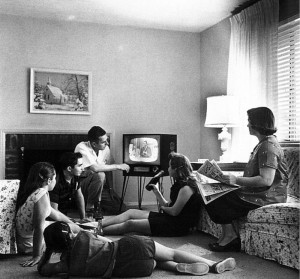 As a teen doing my homework with the tv on in the background, I would hear stuff like "you'll get square eyes", "don't be a couch potato" (image at left, from Wikipedia) and "it's the boob-tube".
As a teen doing my homework with the tv on in the background, I would hear stuff like "you'll get square eyes", "don't be a couch potato" (image at left, from Wikipedia) and "it's the boob-tube".
In other words, tv watching was seen by many older people as something negative and an attack on the social fabric of the family. Today, my family does use the tv, but not that much: it's rarely turned on in our house, though we do watch big events and the news. We also watch DVDs of movies and old television shows on our tv, sitting together as a family. In fact, other screens dominate my life much more: my computer and iPad. But, full disclosure: I've been in front of the computer screen for many hours per week ever since the mid 1980s.
What am I doing with my screens? Not using Facebook, that's for sure, though I'm a Twitter enthusiast, and I hear the same kind of criticism of Twitter as I did for tv, back in the 1960s and 70s.
I have used twitter as a scientific education tool in courses since January 2014. But, it's been touted as a cool pedagogy tool since way before I picked it up. It's proving a great way to get students to practice writing tighter sentences, to keep up to date with science & to communicate with me. My personal experience is that most students simply don't use email for routine communications. I've had many frustrating examples of this.
For me, one of the best uses of twitter is to keep up with international conferences that I don't attend, by following the hashtags from live-tweeters.
That's all: Here's my 4th year Applied Plant Ecology, Biol4090 Twitter Assignment & readings, and also a great Beginners guide to using twitter by @paraphyso.
#solo14ecr Time to plug my beginners Twitter for Academics five-part blog piece. http://t.co/uv2cVIADL1
— Jojo Scoble (@Paraphyso) November 15, 2014
Update: I keep finding more and more journal articles about using Social Media in university teaching, like this one by Domizi and this one by Blessing et al.

